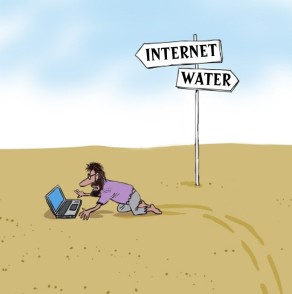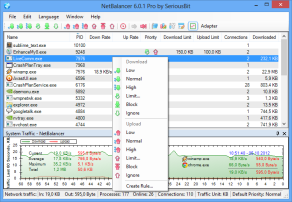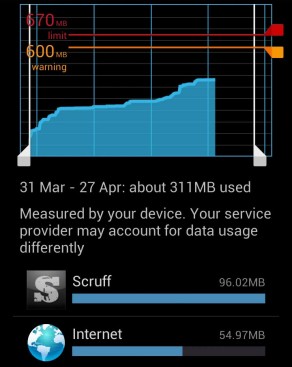
Internet access has become as pervasive and essential as the water we drink. Just as we expect our houses to have running water, so do we expect a reliable flow of data. If you have a house, then this is easy to arrange. A phone call and your home is hooked up with broadband, your personal access ramp to the internet autobahn.
For us nomads, things are more difficult. We don’t have houses, and thus we don’t have broadband. Similar to how the nomads of old moved from water hole to water hole, so do we move from Wi-Fi hotspot to Wi-Fi hotspot, haunting cafes and libraries like starved vampires, leeching the sweet nectar of data from the air.
This works fine as long as you stay in developed countries. But things change when travelling through countries where Internet is a rare and precious resource. In these Wi-Fi deserts, the all-you-can-download buffet of the western world ends and you must start rationing your data.
I recently wandered through such a desert, namely New Zealand. From an Internet point-of-view, New Zealand is a backward third-world country. I found exactly one café with open and unlimited Internet. The rest gave you vouchers for 5-50 Mb of data. That is only enough for basic e-mailing and a small litter of lolcats.
But modern computers assume that the Internet is a Cornucopia from which data flows eternally. In the background, your computer will download security updates, synchronize files and generally mess around. Within a few minutes, you will figuratively see every drop of data dissipate into The Cloud. Then you’ll sit there with your oversized latte, barely sipped, and no Wi-Fi.
There is a way to stop this from happening. NetBalancer is a Windows application with which you can dictate how applications access the Internet. You can for example cut Internet access for all applications except for your browser and your e-mail client. That way, you know that your computer won’t try to sneakily download podcasts when you’re not looking.
The application can also set download/upload limits for applications or give them different priority levels (high priority applications have first dibs on the bandwidth, leaving but a trickle for the less important ones.) But this is icing on the cake. The real value of NetBalancer is to ensure that your limited Internet allowance is not used up by rogue processes.
Data shaping with Android Phones
The first thing I do when I arrive in a new country is to buy a SIM card for my phone. Usually, these buy-as-you-go plans come with a small amount of data. A normal smartphone will burn through this in a day or two, or half an hour if you have Scruff installed. Again, you need a way to ensure that your precious data isn’t wasted.
Android phones have this functionality built in. Under ‘Settings -> Data Usage’, you can set a mobile data limit. The phone will not let you use more mobile data than that limit. Note that it does not count data sent over a Wi-Fi connection, only data taken out of your mobile data plan.
It gets better. You can also see how much data each application has used since a given date, allowing you to detect if an application is abusing your data plan. And if one application is unduly thirsty, you can restrict that application from accessing your mobile data plan from the background. If you open the application to the foreground or connect to a Wi-Fi hotspot, however, the application will again have access to the Internet.
Friends who suffer iPhones report no such functionality in the iOS platform, and I don’t know anyone with a Windows Mobile phone. Please leave suggestions for how to protect a limited bandwidth using iOS, Windows Mobile or Mac in the comments.




What is this Scruff app? (◕‿◕✿) #innocentlook
Install it and find out. Hey, that is a general advice. Might open some doors for the uninitiated!
Ah ha. Now I know who to ask about this when I travel. 🙂
Suicide Hill! Unless one was not pushed first Lol…. Also just started using the Scruff app, thanks for the Android tips.
Not very happily but I would survive. It would certainly make my career difficult though since I work on it. I 100% agree though on rationing the internet. I actually ‘reward’ myself by giving myself free time on it. I only do that once I have completed my daily list of goals. Thanks again for a great blog!
I love internet but i would defentely survive without internet if i hade to.
or would i??? no kontact with my brother on skype 😉
I’m glad you caught that one! 🙂
I would survive – but I would miss it!
Travel in New Zealand and Austrllia is a pain when it comes to finding free or affordable Internet access or Wi-Fi.
South East Asia is at the other end of the spectrum – every place you stay and many places you stop for a coffee etc offer free Wi-Fi.
I just bye a new SIM card for my phone at the airport on arrival at any new country & load say $15 for calls and $5 for Internet access and your away. The staff at the airport SIM card counter will set it all up in less than 5 mins. They will chop a new SIM card down to smart phone size with a pair of SIM card clippers – don’t be alarmed – I have seen this done many times now.
I travel with an iPad also and just create my own “hotspot” with my iPhone if I need/want Internet access on my tablet and I’m out of Wi-Fi range.
I used to lug around a laptop – with its bag and all the other bits and pieces associated with this kind of set up – it was a real burden.
Most airport security checks allow iPads to stay packed away – laptops are required to be taken out of their bags for the X-Ray bag inspections.
If you need a computer from time to time there are plenty of Internet Cafés out there with printers for a small fee.